Hot Workability and Microstructural Evolution of Ti-5.5Al-5Mo-5V-2Nb-1Fe-1Zr Titanium Alloy Based on the Different Phase Zones during Plastic Deformation at High Temperatures
Abstract
1. Introduction
2. Materials and Methods
3. Results and Discussion
3.1. Establishing Processing Map of Ti555211 Alloy
3.2. Microstructural Evolution of Ti555211 Alloy
3.2.1. Microstructures of Ti555211 Alloy with Dual Phases
3.2.2. Microstructures of Ti555211 Alloy with Single Phase
4. Conclusions
- True stress–strain curves of Ti555211 alloy are obtained based on compressive test at high temperatures. It is found that flow stress increases with reducing temperatures and it decreases with the reducing strain rate during compressive deformation of Ti555211 sample. This indicates that Ti555211 alloy is sensitive to the strain rate during compression at high temperatures;
- It can be found that Ti555211 samples deformed at 750 and 850 °C are composed of α and β phases, whereas Ti555211 samples deformed at 950 and 1050 °C consist of single β phase. When Ti555211 sample undergoes compressive deformation in α + β phase region, the microstructures of α phase vary more substantially than those of β phase, which means that plastic deformation of Ti555211 sample is governed by β phase;
- The processing maps of Ti555211 alloy are constructed according to dynamic material model, where the process parameters for hot working are optimized. It can be found that Ti555211 alloy generally possesses the better hot workability in single β phase region. In single β phase region of Ti555211 alloy, the best hot processing parameters involve temperature range from 925 to 1025 °C and the strain rate range from 0.005 to 0.03 s−1.
Author Contributions
Funding
Data Availability Statement
Acknowledgments
Conflicts of Interest
References
- Yu, G.X.; Zhao, D.X.; Li, K.; Chen, W.; Zhang, J.Y.; Liu, J.X.; Li, R.; Wang, X.X.; Sun, J. Homogeneous α-precipitation and enhanced plasticity in Ti-6Cr-5Mo-5V-4Al high-strength metastable titanium alloy with heterogenous β-structure. Mater. Sci. Eng. A 2022, 858, 144180. [Google Scholar] [CrossRef]
- Xu, T.W.; Li, J.S.; Zhang, S.S.; Zhang, F.S.; Liu, X.H. Cold deformation behavior of the Ti-15Mo-3Al-2.7Nb-0.2Si alloy and its effect on a precipitation and tensile properties in aging treatment. J. Alloys Compd. 2016, 682, 404–411. [Google Scholar] [CrossRef]
- Zhang, W.D.; Liu, Y.; Wu, H.; Liu, B.; Chen, Z.J.; Tang, H.P. Microstructural evolution during hot and cold deformation of Ti-36Nb-2Ta-3Zr-0.35O alloy. Trans. Nonferr. Met. Soc. China 2016, 26, 1310–1316. [Google Scholar] [CrossRef]
- Wu, Y.; Wang, T.; Ren, Z.K.; Liu, Y.M.; Huang, Q.X. Evolution mechanism of microstructure and bond strength based on interface diffusion and IMCs of Ti/steel clad plates fabricated by double-layered hot rolling. J. Mater. Process. Technol. 2022, 310, 117780. [Google Scholar] [CrossRef]
- Gupta, A.; Khatirkar, R.; Singh, J. A review of microstructure and texture evolution during plastic deformation and heat treatment of β-Ti alloys. J. Alloys Compd. 2022, 899, 163242. [Google Scholar] [CrossRef]
- Ducreux, C.I.P.; Saleh, A.A.; Gazder, A.A.; Pereloma, E.V. An in-situ neutron diffraction investigation of martensitic transformation in a metastable β Ti-10V-2Fe-3Al alloy during uniaxial tension. J. Alloys Compd. 2021, 869, 159301. [Google Scholar] [CrossRef]
- Jiang, Y.Q.; Lin, Y.C.; Wang, G.Q.; Pang, G.D.; Chen, M.S.; Huang, Z.C. Microstructure evolution and a unified constitutive model for a Ti-55511alloy deformed in β region. J. Alloys Compd. 2021, 870, 159534. [Google Scholar] [CrossRef]
- Li, L.; Li, M.Q. Further mechanism of α/β interphase boundary evolution and dynamic globularization of Ti-5Al-2Sn-2Zr-4Mo-4Cr at elevated temperature deformation. Prog. Nat. Sci.-Mater. 2022, 32, 490–497. [Google Scholar] [CrossRef]
- Hariharan, A.; Goldberg, P.; Gustmann, T.; Maawad, E.; Pilz, S.; Schell, F.; Kunze, T.; Zwahr, C.; Gebert, A. Designing the microstructural constituents of an additively manufactured near β Ti alloy for an enhanced mechanical and corrosion response. Mater. Des. 2022, 217, 110618. [Google Scholar] [CrossRef]
- Li, L.; Li, M.Q.; Luo, J. Mechanism in the β phase evolution during hot deformation of Ti-5Al-2Sn-2Zr-4Mo-4Cr with a transformed microstructure. Acta Mater. 2015, 94, 36–45. [Google Scholar] [CrossRef]
- Lu, T.; Dan, Z.H.; Li, T.J.; Dai, G.Q.; Sun, Y.Y.; Guo, Y.H.; Li, K.; Yi, D.Q.; Chang, H.; Zhou, L. Flow softening and microstructural evolution of near β titanium alloy Ti-35421 during hot compression deformation in the α+β region. J. Mater. Res. Technol. 2022, 19, 2257–2274. [Google Scholar] [CrossRef]
- Ratochka, I.V.; Naydenkin, E.V.; Mishin, I.P.; Lykova, O.N.; Zabudchenko, O.V. Low-temperature superplasticity of ultrafine-grained near β titanium alloy. J. Alloys Compd. 2021, 891, 161981. [Google Scholar] [CrossRef]
- Guo, H.J.; Liu, P.; Qin, X.P.; Song, Y.L.; Qian, D.S.; Xie, L.C.; Wang, L.Q.; Zhang, L.C.; Hua, L. Electroshock treatment dependent microstructural evolution and mechanical properties of near-β titanium alloy manufactured by directed energy deposition. Mater. Des. 2021, 212, 110286. [Google Scholar] [CrossRef]
- Ebrahimi, M.; Wang, Q.D.; Attarilar, S. A comprehensive review of magnesium-based alloys and composites processed by cyclic extrusion compression and the related techniques. Prog. Mater. Sci. 2023, 131, 101016. [Google Scholar] [CrossRef]
- Ghosh, S.; Hamad, A.; Patnamsetty, M.; Borek, W.; Gouda, M.; Chiba, A.; Ebied, S. Constitutive modeling and hot deformation processing map of a new biomaterial Ti-14Cr alloy. J. Mater. Res. Technol. 2022, 20, 4097–4113. [Google Scholar] [CrossRef]
- Jin, H.J.; Shi, S.B.; Li, J.J.; Wang, X.X.; Yang, C.X. A new β-Ti alloy with good tensile properties by the mixed microstructure characteristics of α phase. J. Alloys Compd. 2022, 925, 166755. [Google Scholar] [CrossRef]
- Prasad, Y.V.R.K.; Gegel, H.L.; Doraivelu, S.M.; Malas, J.C.; Morgan, J.T.; Lark, K.A.; Barker, D.R. Modeling of dynamic material behavior in hot deformation: Forging of Ti6242. Metall. Mater. Trans. A 1984, 15, 1883–1892. [Google Scholar] [CrossRef]
- Sun, D.; Zhang, Y.Q.; Jiang, S.Y.; Yu, J.B.; Yan, B.Y. Investigation on hot workability of Ti-37 at% Nb alloy based on processing map and microstructural evolution. Metall. Mater. Trans. A 2021, 52, 2830–2844. [Google Scholar] [CrossRef]
- Zhang, Y.Q.; Jiang, S.Y.; Chen, C.; Hu, L.; Zhu, X.M. Hot workability of a NiTiCu shape memory alloy with acicular martensite phase based on processing maps. Intermetallics 2017, 86, 94–103. [Google Scholar] [CrossRef]
- Wang, Y.; Jiang, S.Y.; Zhang, Y.Q. Processing Map of NiTiNb Shape Memory Alloy Subjected to Plastic Deformation at High Temperatures. Metals 2017, 7, 328. [Google Scholar] [CrossRef]
- Zhang, Y.Q.; Jiang, S.Y.; Zhao, Y.N.; Shan, D.B. Isothermal precision forging of complex-shape rotating disk of aluminum alloy based on processing map and digitized technology. Mater. Sci. Eng. A 2013, 580, 294–304. [Google Scholar] [CrossRef]
- Seyed-Salehi, M.; Kim, B.H.; Yang, S.Y.; Kim, S.K.; Eisaabadi Bozchalei, G. Effect of Cr elimination on flow behavior and processing map of newly developed ECO-7175 aluminum alloy during hot compression. Trans. Nonferr. Met. Soc. China 2022, 32, 1442–1459. [Google Scholar] [CrossRef]
- Chi, Z.L.; Ren, S.; Qiao, J.B.; Qu, J.L.; Yang, C.B.; Xie, Z.Y.; Chen, W.; Zhang, H.; Jiang, L.; Chen, S.Y.; et al. Failure behaviors and processing maps with failure domains for hot compression of a powder metallurgy Ni-based superalloy. J. Mater. Res. Technol. 2022, 20, 3860–3874. [Google Scholar] [CrossRef]
- Lei, C.; Wang, Q.D.; Tang, H.P.; Liu, T.W.; Li, Z.Y.; Jiang, H.Y.; Wang, K.; Ebrahimi, M.; Ding, W.J. Hot deformation constitutive model and processing maps of homogenized Al-5Mg-3Zn-1Cu alloy. J. Mater. Res. Technol. 2021, 14, 324–339. [Google Scholar] [CrossRef]
- An, Z.; Li, J.S.; Feng, Y. Optimization of thermal processing parameters of Ti555211 alloy using processing maps based on Murty criterion. Rare Met. 2016, 35, 154–161. [Google Scholar] [CrossRef]
- An, Z.; Wang, Z.L.; Xue, F.; Mao, X.N.; Li, L.; Ding, X. Investigation on Thermal Processing Map of Ti555211 Alloy Based on Dynamic Material Model. Chin. J. Rare Met. 2019, 43, 706–712. [Google Scholar]
- Evans, R.W.; Scharning, P.J. Axisymmetric compression test and hot working properties of alloys. Mater. Sci. Technol. 2001, 17, 995–1004. [Google Scholar] [CrossRef]
- Wan, Z.P.; Hu, L.X.; Sun, Y.; Wang, T.; Li, Z. Hot deformation behavior and processing workability of a Ni-based alloy. J. Alloys Compd. 2018, 769, 367–375. [Google Scholar] [CrossRef]
- Gao, Y.; Xue, X.; Gao, H.; Luo, W.; Wang, K.; Li, S.; Liu, X.; Du, Y. Investigation of High-Temperature Constitutive Behavior of Ti555211 Titanium Alloy Subjected to Plastic Deformation in the Different Phase Regions. Metals 2022, 12, 1562. [Google Scholar] [CrossRef]
- Kwak, T.K.; Kim, W.J. Effect of refinement of grains and icosahedral phase on hot compressive deformation and processing maps of Mg-Zn-Y magnesium alloys with different volume fractions of icosahedral phase. J. Sci. Technol. 2019, 35, 181–191. [Google Scholar] [CrossRef]
- Sun, Y.; Feng, X.Y.; Hu, L.X.; Zhang, H.; Zhang, H.Z. Characterization on hot deformation behavior of Ti-22Al-25Nb alloy using a combination of 3D processing maps and finite element simulation method. J. Alloys Compd. 2018, 753, 256–271. [Google Scholar] [CrossRef]
- Prasad, Y.V.R.K.; Seshacharyulu, T. Modelling of hot deformation for microstructural control. Int. Mater. Rev. 1998, 43, 243–258. [Google Scholar] [CrossRef]
- Jiang, S.Y.; Wang, Y.; Yan, B.Y.; Zhang, Y.Q. Hot workability of FeMnSiCrNi shape memory alloy based on processing map and martensitic transformation. J. Alloys Compd. 2019, 806, 1153–1165. [Google Scholar] [CrossRef]
- Zang, M.C.; Niu, H.Z.; Yu, J.S.; Zhang, H.R.; Zhang, T.B.; Zhang, D.L. Cryogenic tensile properties and deformation behavior of a fine-grained near alpha titanium alloy with an equiaxed microstructure. Mater. Sci. Eng. A 2022, 840, 142952. [Google Scholar] [CrossRef]
- Chen, W.; Li, Q.F.; Zhou, L.B.; Li, C.; Qiu, W.; Chen, J.; Lin, Y.C.; Zhou, K.C. Limit of cold deformation in a near β-Ti alloy: Role of a′ phases on the failure of β phase during cold rolling. J. Mater. Res. Technol. 2022, 20, 2385–2393. [Google Scholar] [CrossRef]

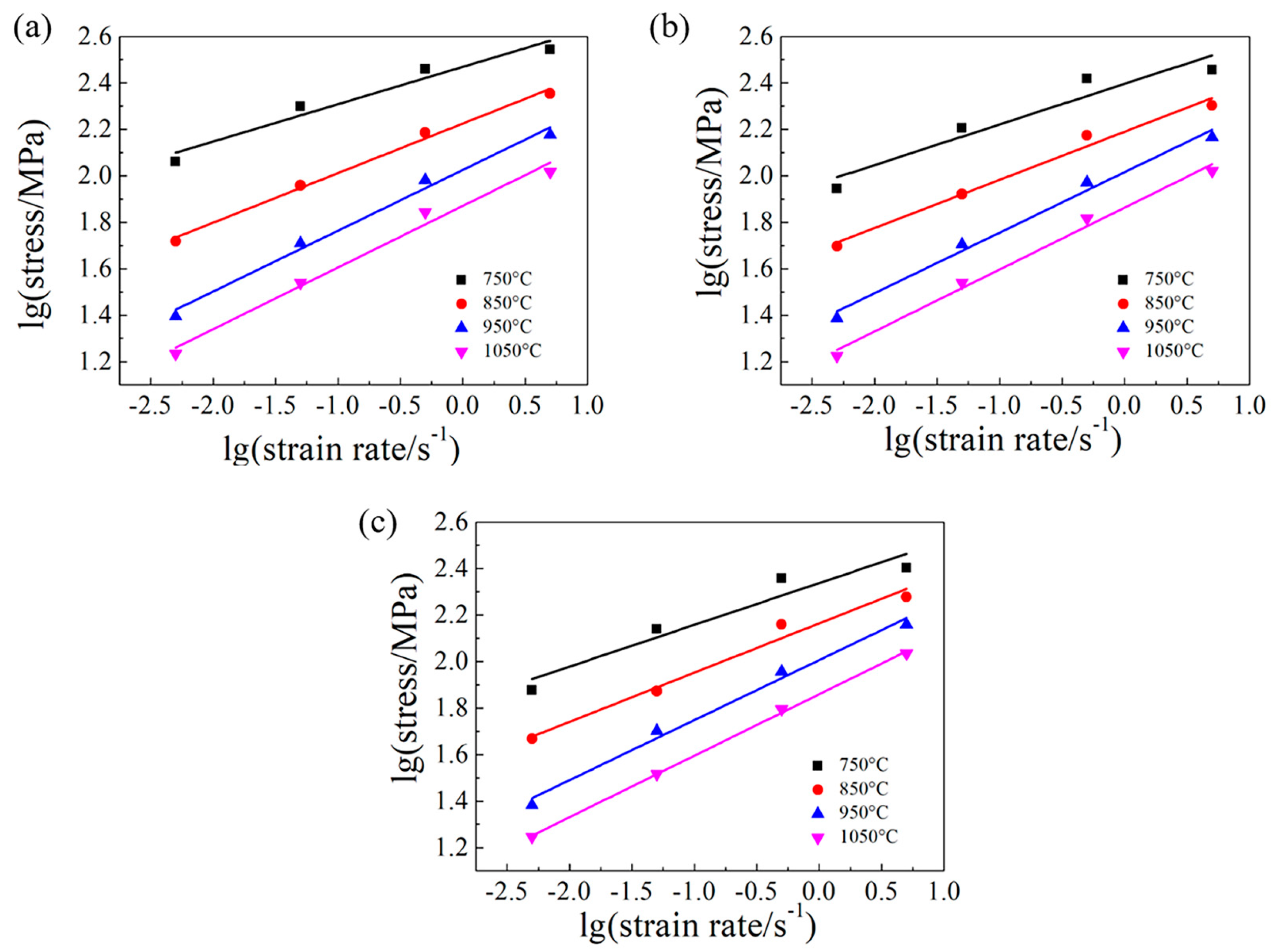
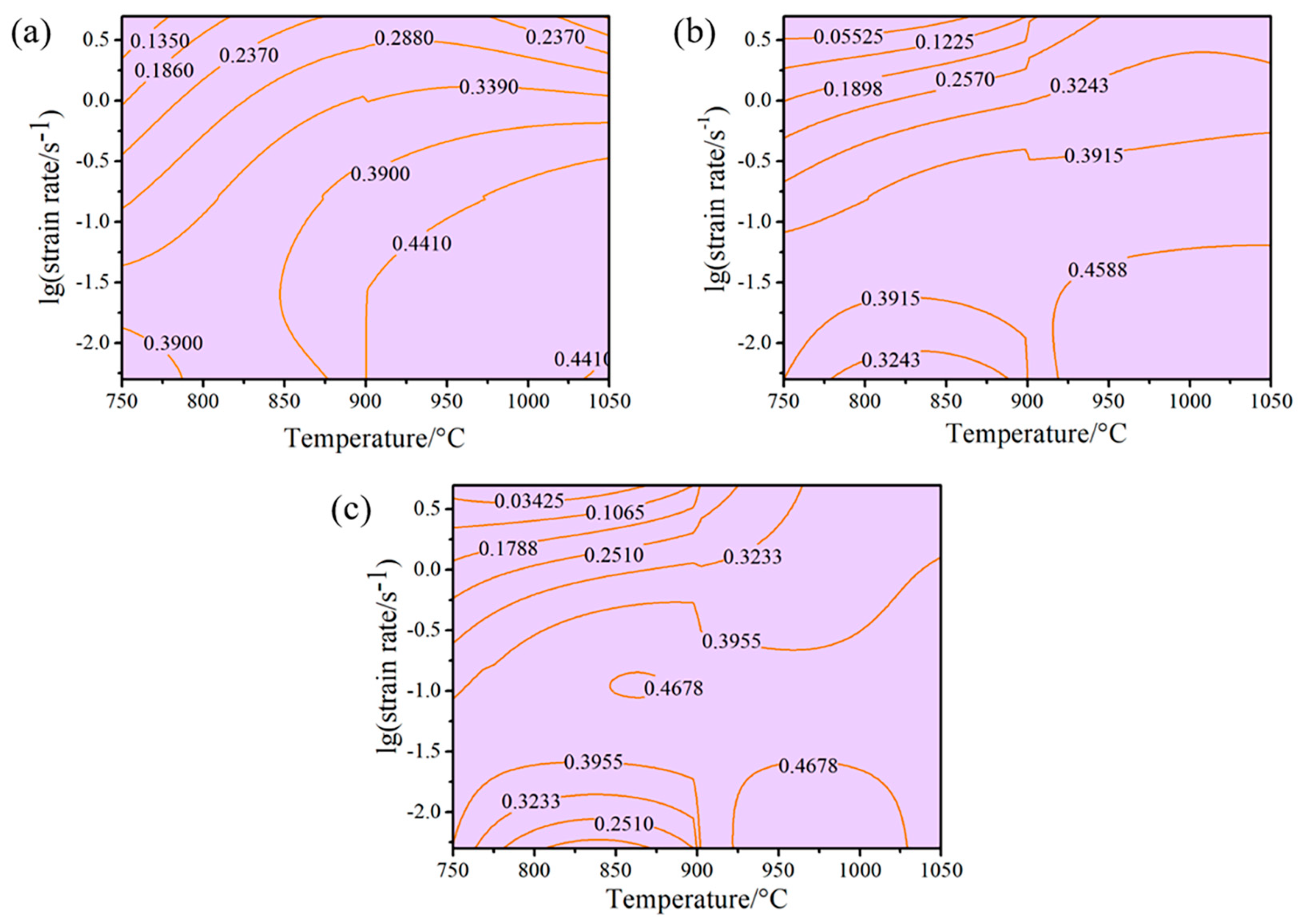
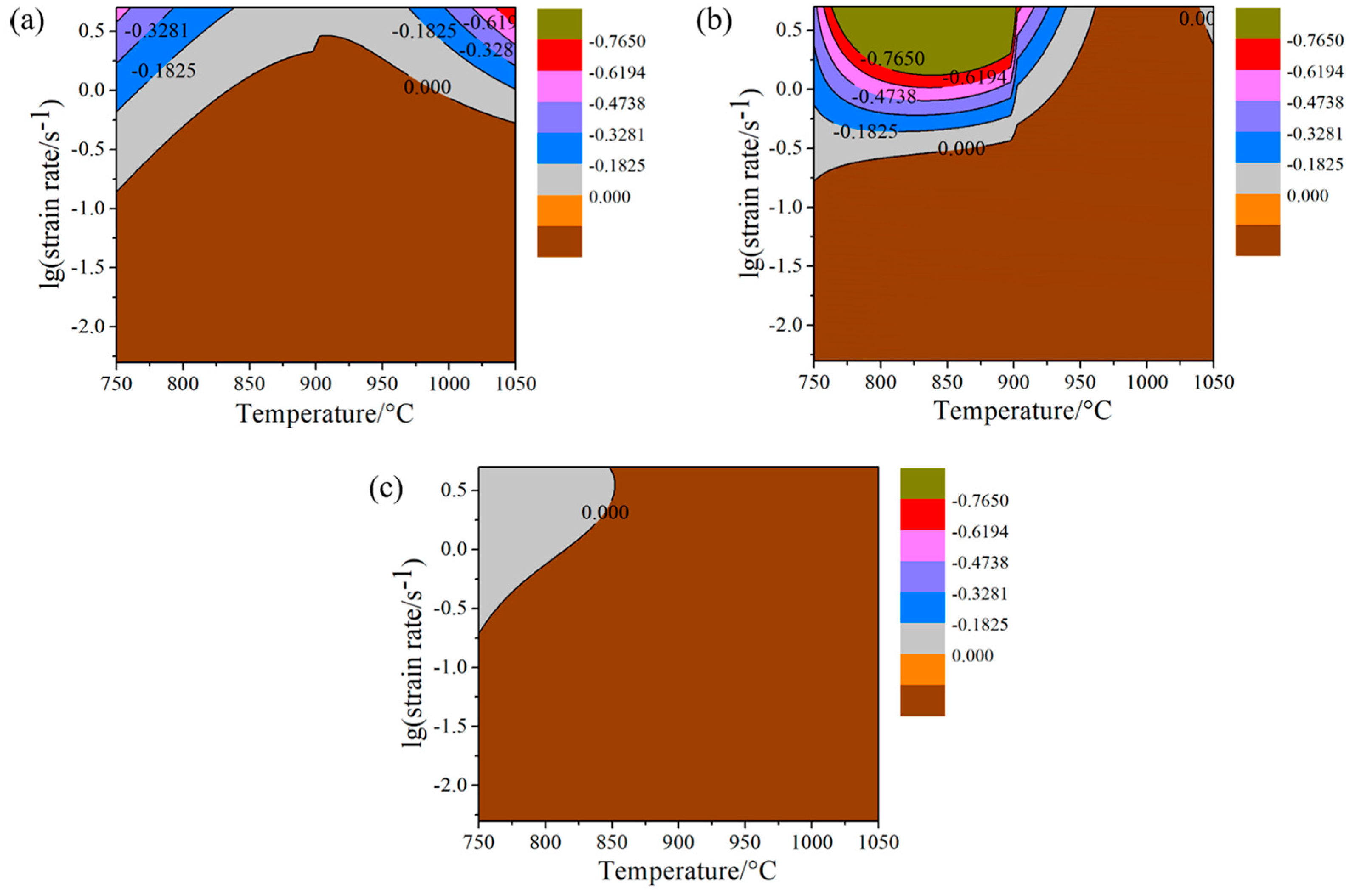

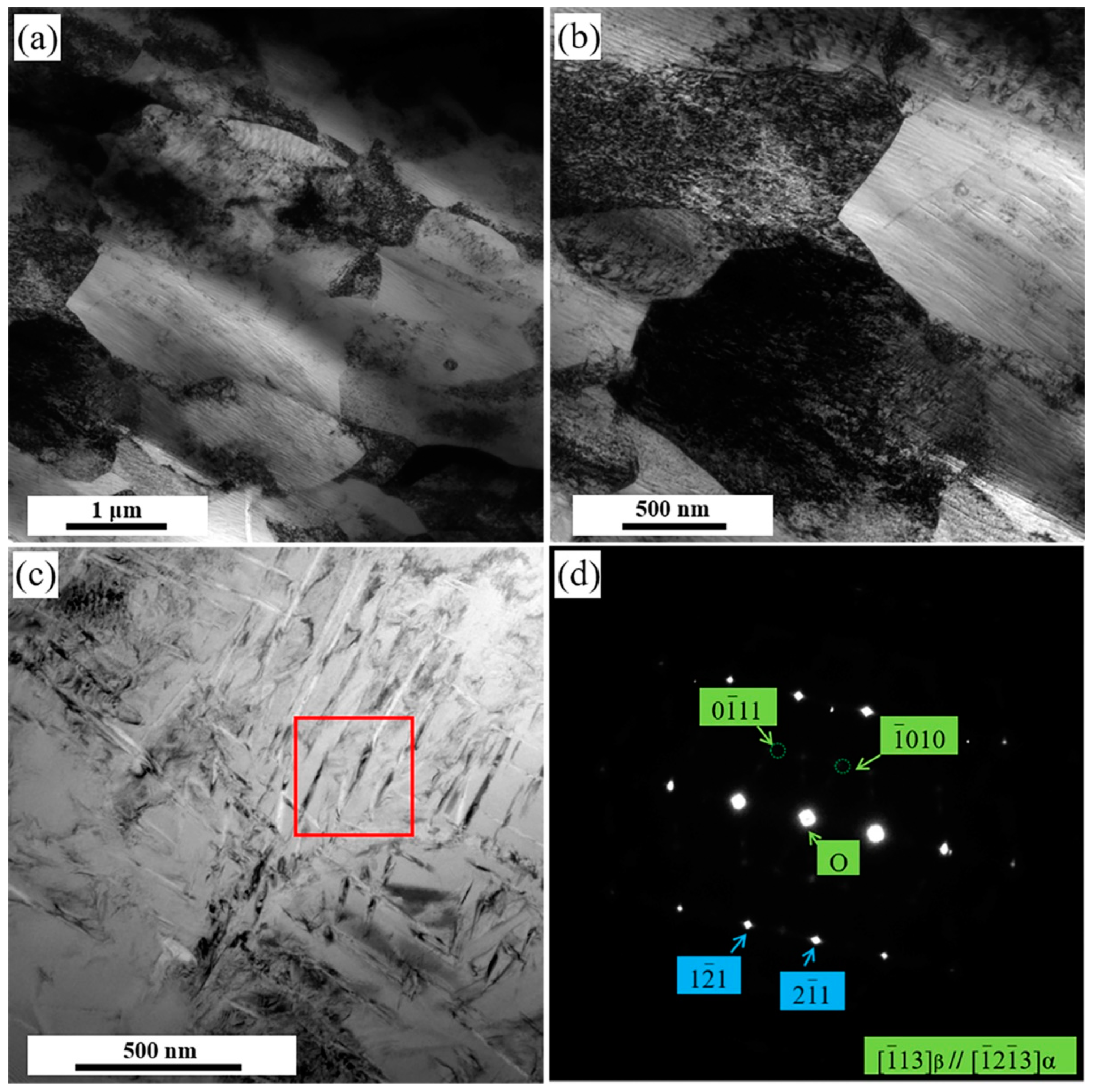
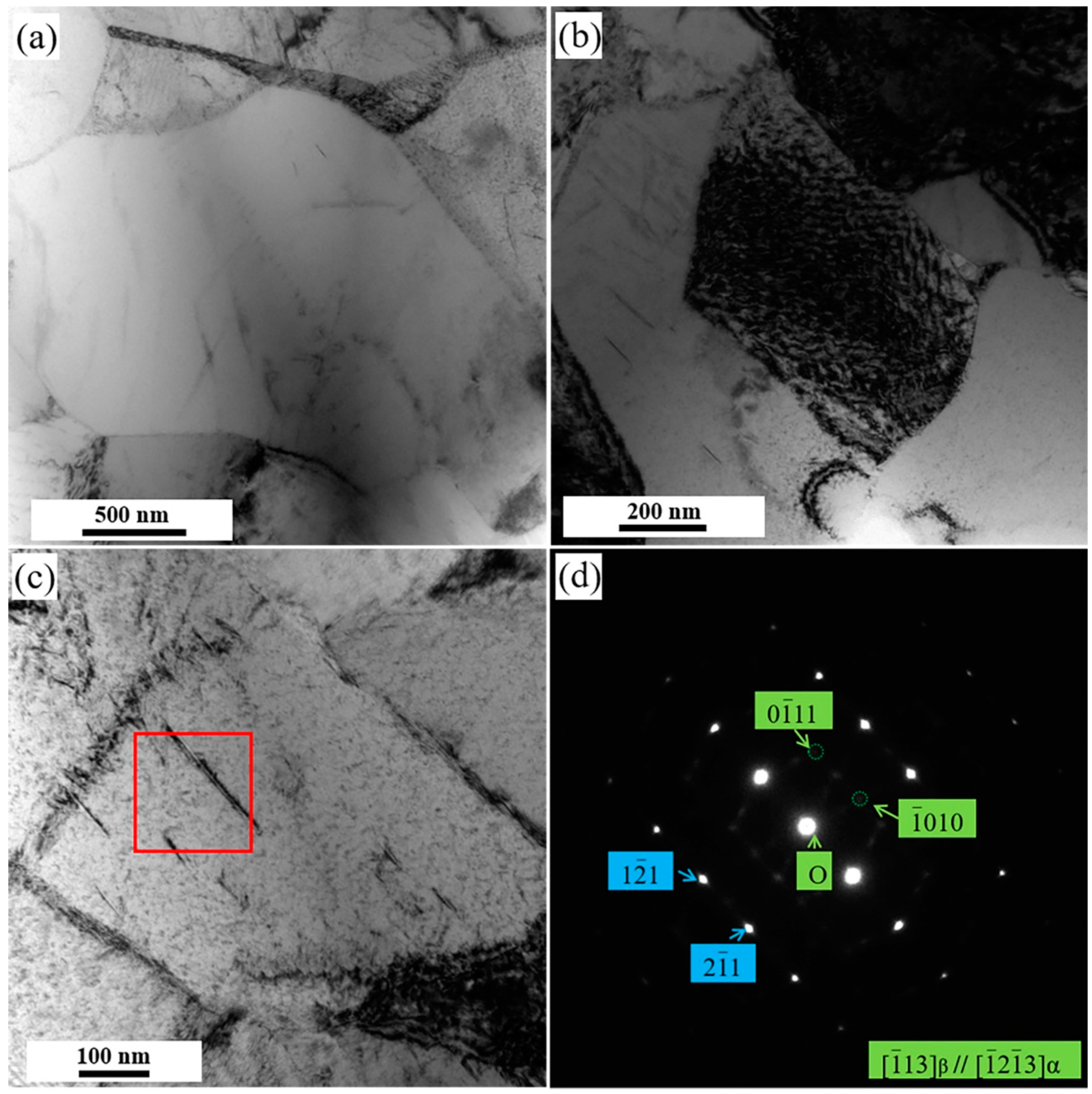
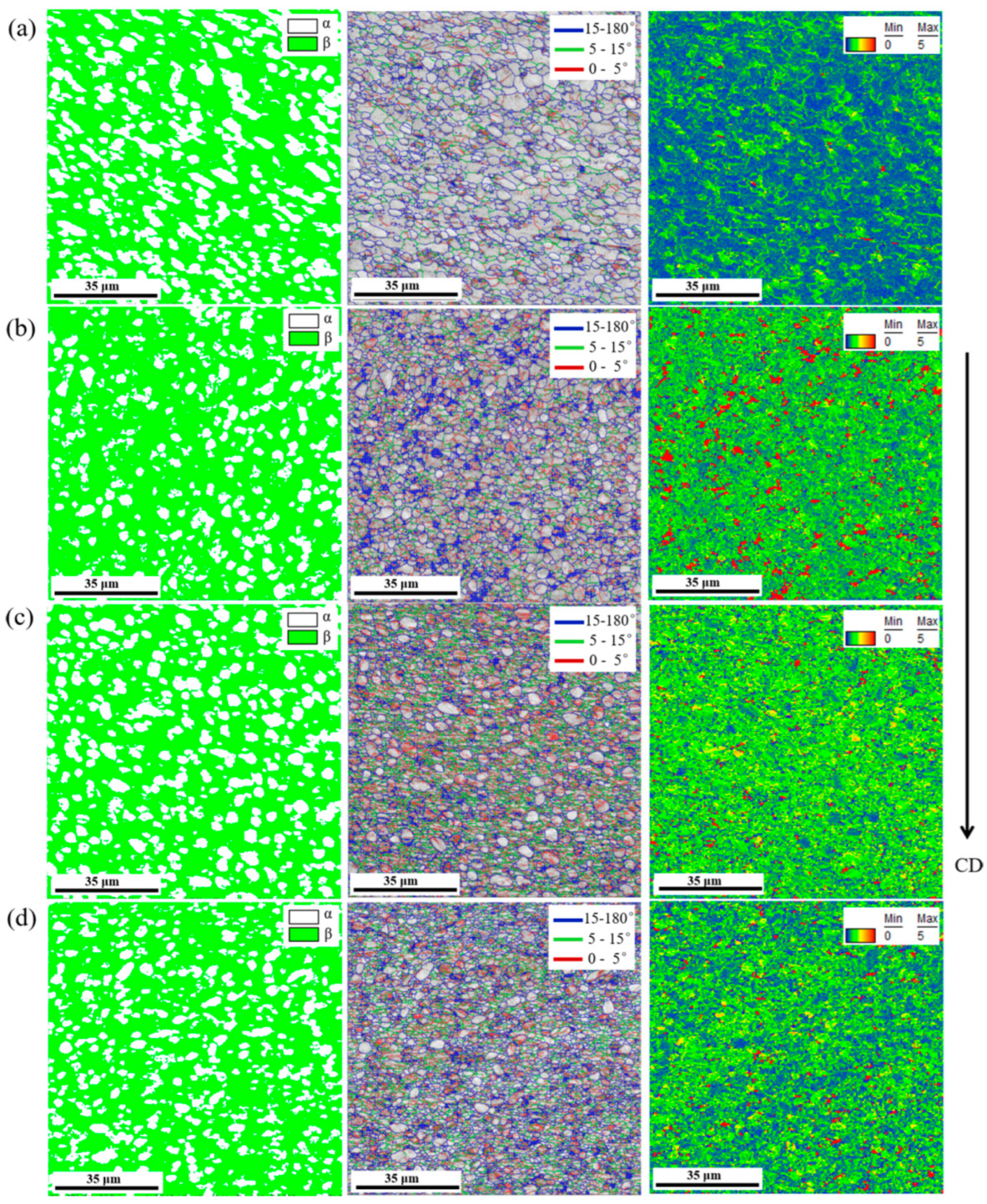
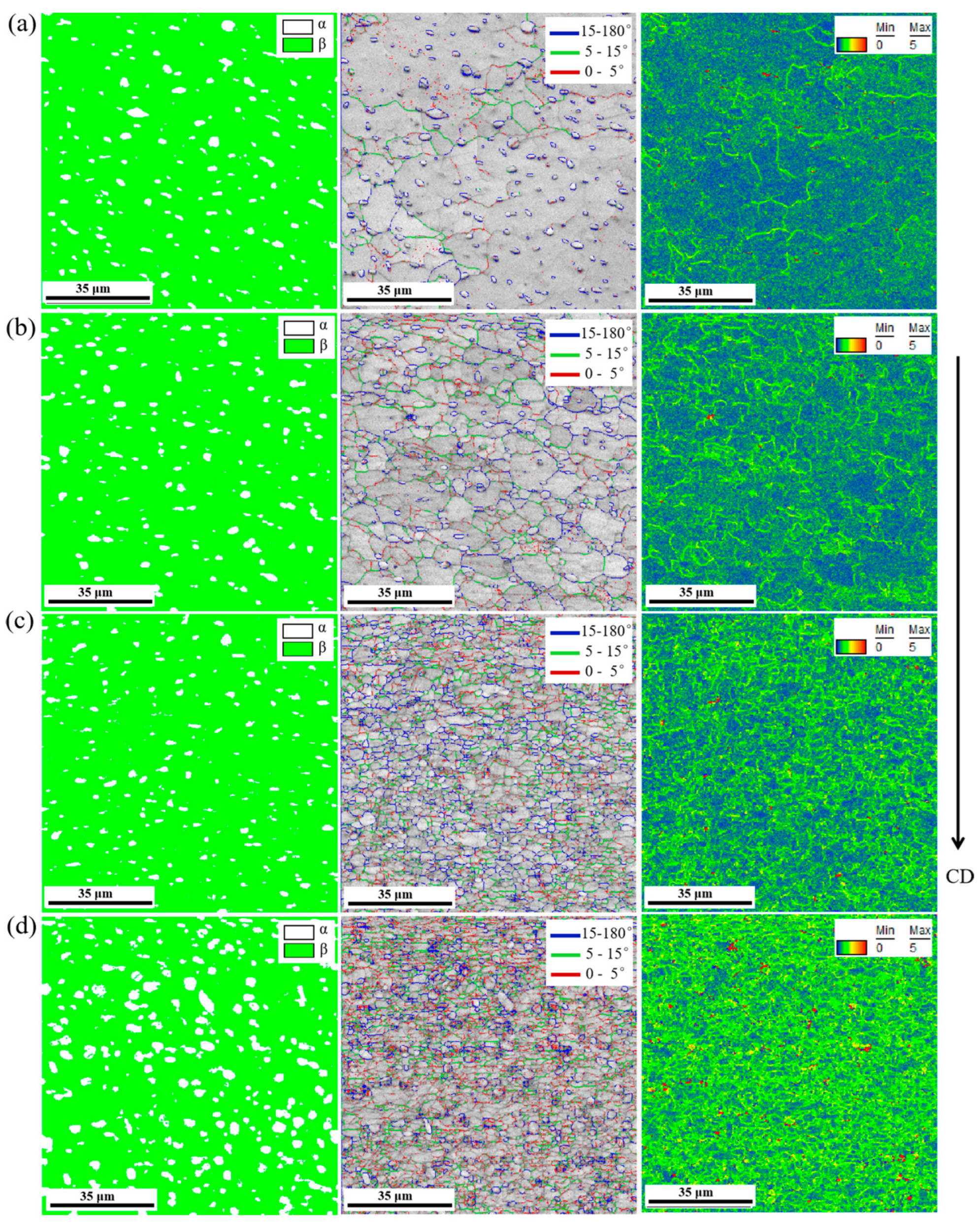
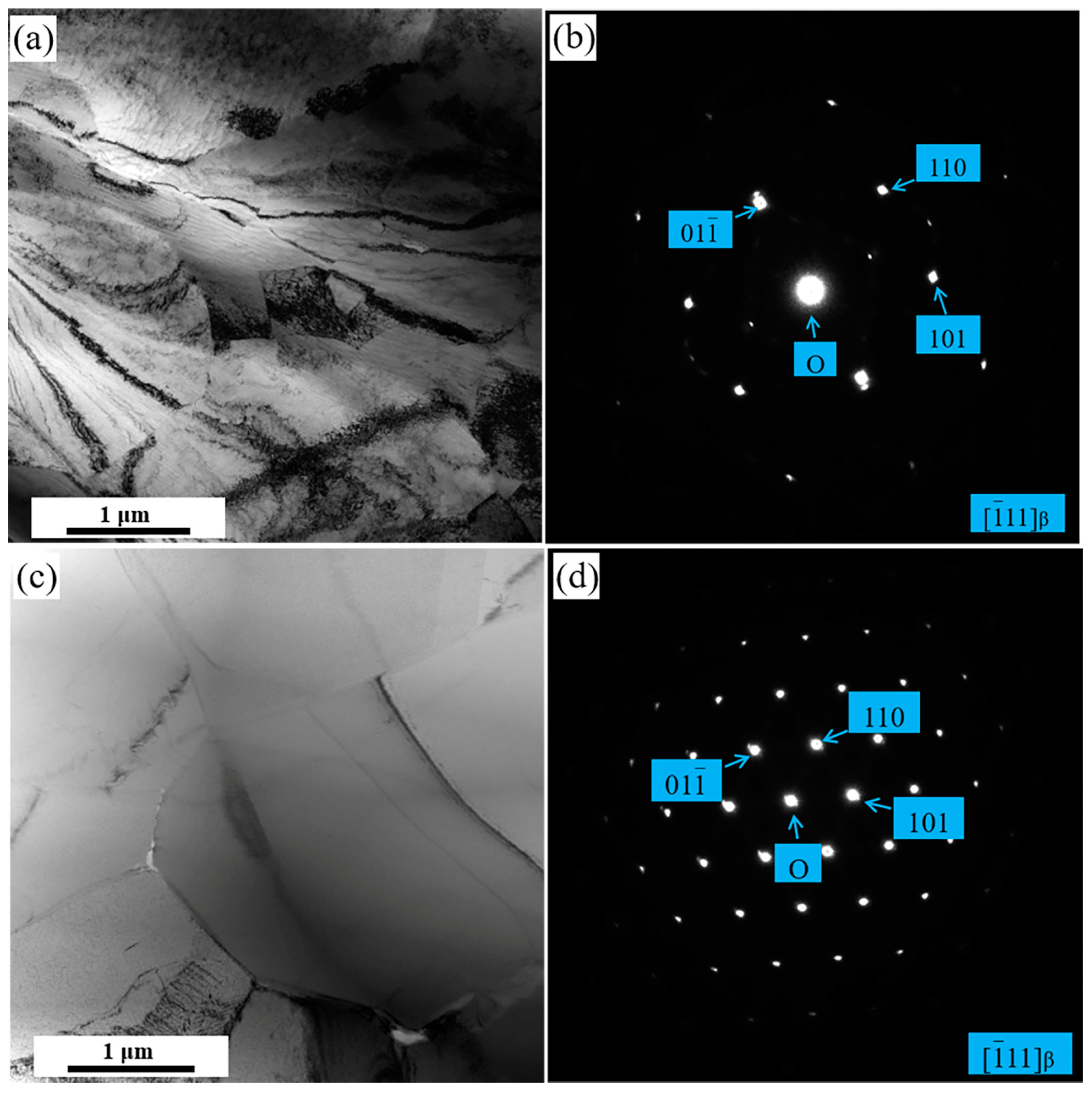
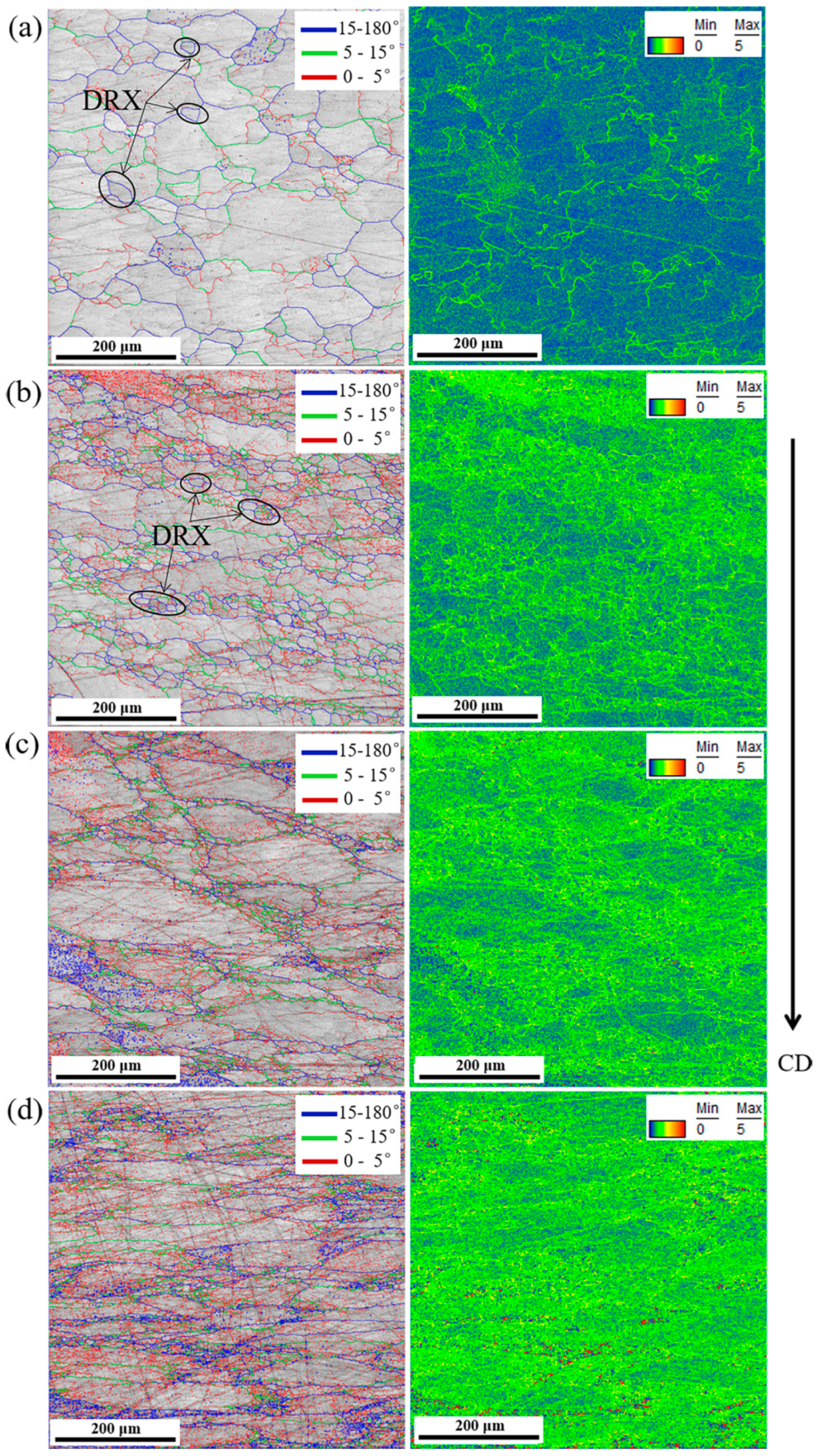

| T/°C | |||||
|---|---|---|---|---|---|
| 750 | 850 | 950 | 1050 | ||
| 0.3 | 0.005 | 115 | 52 | 24 | 17 |
| 0.05 | 198 | 90 | 51 | 34 | |
| 0.5 | 288 | 153 | 95 | 69 | |
| 5 | 349 | 226 | 150 | 104 | |
| 0.6 | 0.005 | 88 | 49 | 24 | 16 |
| 0.05 | 160 | 83 | 50 | 34 | |
| 0.5 | 262 | 149 | 93 | 65 | |
| 5 | 286 | 201 | 146 | 104 | |
| 0.9 | 0.005 | 75 | 46 | 24 | 17 |
| 0.05 | 137 | 74 | 50 | 32 | |
| 0.5 | 227 | 144 | 90 | 62 | |
| 5 | 252 | 189 | 143 | 108 | |
Disclaimer/Publisher’s Note: The statements, opinions and data contained in all publications are solely those of the individual author(s) and contributor(s) and not of MDPI and/or the editor(s). MDPI and/or the editor(s) disclaim responsibility for any injury to people or property resulting from any ideas, methods, instructions or products referred to in the content. |
© 2023 by the authors. Licensee MDPI, Basel, Switzerland. This article is an open access article distributed under the terms and conditions of the Creative Commons Attribution (CC BY) license (https://creativecommons.org/licenses/by/4.0/).
Share and Cite
Gao, Y.; Liu, X.; Chen, H.; Xue, X.; Gao, H.; Luo, W.; Wang, K.; Li, S.; Du, Y. Hot Workability and Microstructural Evolution of Ti-5.5Al-5Mo-5V-2Nb-1Fe-1Zr Titanium Alloy Based on the Different Phase Zones during Plastic Deformation at High Temperatures. Metals 2023, 13, 92. https://doi.org/10.3390/met13010092
Gao Y, Liu X, Chen H, Xue X, Gao H, Luo W, Wang K, Li S, Du Y. Hot Workability and Microstructural Evolution of Ti-5.5Al-5Mo-5V-2Nb-1Fe-1Zr Titanium Alloy Based on the Different Phase Zones during Plastic Deformation at High Temperatures. Metals. 2023; 13(1):92. https://doi.org/10.3390/met13010092
Chicago/Turabian StyleGao, Yushe, Xianghong Liu, Haisheng Chen, Xiangyi Xue, Huixian Gao, Wenzhong Luo, Kaixuan Wang, Shaoqiang Li, and Yuxuan Du. 2023. "Hot Workability and Microstructural Evolution of Ti-5.5Al-5Mo-5V-2Nb-1Fe-1Zr Titanium Alloy Based on the Different Phase Zones during Plastic Deformation at High Temperatures" Metals 13, no. 1: 92. https://doi.org/10.3390/met13010092
APA StyleGao, Y., Liu, X., Chen, H., Xue, X., Gao, H., Luo, W., Wang, K., Li, S., & Du, Y. (2023). Hot Workability and Microstructural Evolution of Ti-5.5Al-5Mo-5V-2Nb-1Fe-1Zr Titanium Alloy Based on the Different Phase Zones during Plastic Deformation at High Temperatures. Metals, 13(1), 92. https://doi.org/10.3390/met13010092





